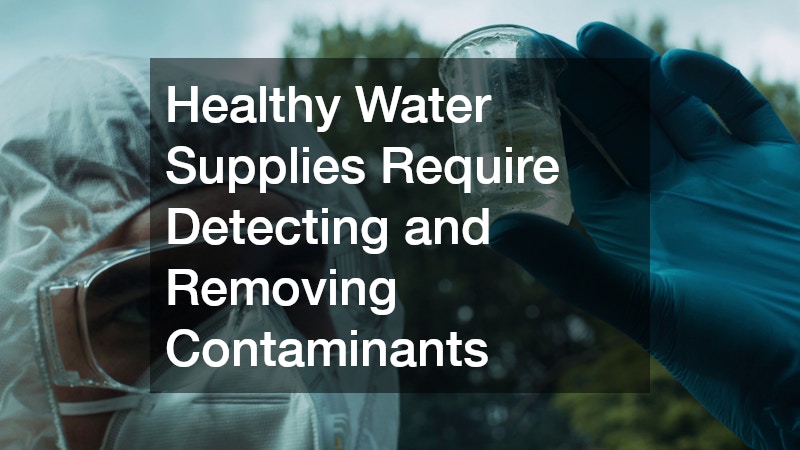Clean and safe drinking water is a fundamental human need, yet it is consistently threatened by various harmful contaminants. The presence of these pollutants affects public health, leading to an increased risk of waterborne diseases and long-term health complications, as well as impacting biodiversity and ecosystems.
What Are the Most Common Contaminants Found in Water Supplies?
Biological Contaminants
Water supplies can host a variety of microorganisms, including bacteria, viruses, and protozoans, which pose serious health risks. For instance, pathogens like Escherichia coli and Giardia lamblia are notorious for causing severe gastrointestinal illnesses when ingested through contaminated water.
In developing countries, biological contaminants often contribute to a high incidence of waterborne diseases due to inadequate water treatment facilities. Even in developed regions, unforeseen factors such as flooding or infrastructure failures can lead to bacterial contamination.
Studies indicate that waterborne pathogens are responsible for millions of cases of disease annually, underscoring the critical need for effective purification methods. Continuous monitoring and improvements in sanitation can mitigate the risk posed by these biological threats.
Chemical Contaminants
Chemical pollutants in water include a diverse array of substances such as heavy metals, industrial chemicals, and agricultural pesticides. These contaminants enter water supplies through activities like industrial runoff, agricultural practices, and improper disposal of pharmaceuticals.
Heavy metals like lead and mercury are especially concerning due to their toxicity and ability to accumulate in the body, causing neurological and developmental issues. Pesticides, though beneficial for agriculture, can leach into groundwater, presenting risks to both human and aquatic life.
Efforts to monitor and reduce chemical pollutants have increased with advanced detection technology and stricter environmental regulations. Public awareness and reduction in chemical usage contribute significantly to decreasing these contaminants in water sources.
How Can Harmful Contaminants Be Effectively Removed from Water?
Filtration Techniques
Activated carbon filtration is one of the most common methods used to treat water, effectively removing organic compounds and residual chlorine. This technique uses porous carbon to adsorb contaminants, improving the taste and safety of the water.
Reverse osmosis is another widely used method, utilizing a semi-permeable membrane to separate contaminants from water molecules. It is particularly effective in removing dissolved salts, fluoride, and other inorganic chemicals.
The combination of multiple filtration methods often provides a more comprehensive solution for small and large-scale water treatment systems. Continuous innovation in filtration techniques promises enhanced removal efficiency for a wider range of contaminants.
Advanced Treatment Technologies
Ultraviolet (UV) treatment is an advanced technology that disinfects water by inactivating microorganisms’ genetic material, rendering them harmless. This method is chemical-free, making it an environmentally friendly option for municipal water systems.
Nanotechnology introduces promising solutions for water purification, with nanoparticles designed to target and remove specific contaminants at the molecular level. Such technologies can enhance existing systems, providing long-lasting and effective contaminant removal.
Despite their potential, the implementation of advanced treatment technologies requires consideration of cost and feasibility for widespread use. As technology advances, the adoption of innovative solutions could transform global water treatment practices.
What Are the Regulations and Standards for Safe Drinking Water?
Government Regulations
Many countries have established regulations to protect drinking water, such as the Safe Drinking Water Act (SDWA) in the United States, which sets maximum contaminant levels for harmful substances. These laws are crucial in ensuring public safety and providing a baseline for water quality management.
Compliance with these regulations involves regular monitoring and reporting by water supply agencies, along with timely upgrades in treatment infrastructure. Enforcement of regulations and penalties for non-compliance play a vital role in maintaining high water quality standards.
Internationally, entities such as the European Union have similar directives that emphasize the protection of water resources and promote sustainable use. Collaborative initiatives among countries can further strengthen efforts to achieve safe drinking water for all populations.
Industry Standards
Organizations such as the World Health Organization (WHO) provide guidelines that set benchmarks for water quality, encouraging nations to strive for optimal standards. WHO guidelines offer a framework that balances health protection with feasible implementation in various regions worldwide.
Additionally, industry standards developed by the International Organization for Standardization (ISO) facilitate consistency in water quality testing and treatment approaches. ISO standards support the development of reliable, safe, and sustainable water management practices across industries.
The alignment of national regulations with these global benchmarks helps ensure comprehensive protection of water resources. As industries adopt these standards, the resilience and safety of water infrastructure are enhanced, providing reassurance to consumers.
Ensuring healthy water supplies necessitates a multifaceted approach to identify, monitor, and effectively remove harmful contaminants. Through a combination of proven and emerging treatment technologies, the impact of biological and chemical contaminants can be minimized.
Regulations and standards, championed by national regulations and international guidelines, serve as critical frameworks in safeguarding water quality. Continued commitment and innovation in this sector are essential for achieving global access to safe and clean water.



